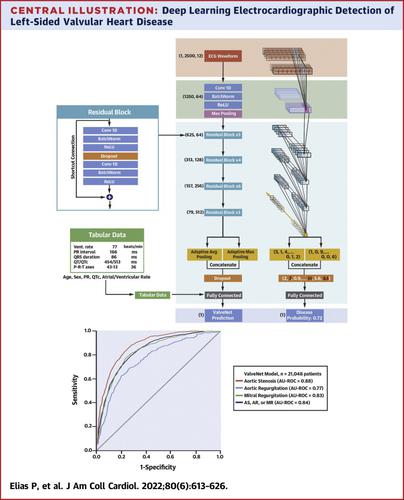Journal of the American College of Cardiology ( IF 24.0 ) Pub Date : 2022-08-01 , DOI: 10.1016/j.jacc.2022.05.029 Pierre Elias 1 , Timothy J Poterucha 1 , Vijay Rajaram 1 , Luca Matos Moller 1 , Victor Rodriguez 2 , Shreyas Bhave 2 , Rebecca T Hahn 1 , Geoffrey Tison 3 , Sean A Abreau 3 , Joshua Barrios 3 , Jessica Nicole Torres 4 , J Weston Hughes 4 , Marco V Perez 4 , Joshua Finer 5 , Susheel Kodali 1 , Omar Khalique 1 , Nadira Hamid 1 , Allan Schwartz 1 , Shunichi Homma 1 , Deepa Kumaraiah 1 , David J Cohen 6 , Mathew S Maurer 1 , Andrew J Einstein 1 , Tamim Nazif 1 , Martin B Leon 7 , Adler J Perotte 2

|
Background
Valvular heart disease is an important contributor to cardiovascular morbidity and mortality and remains underdiagnosed. Deep learning analysis of electrocardiography (ECG) may be useful in detecting aortic stenosis (AS), aortic regurgitation (AR), and mitral regurgitation (MR).
Objectives
This study aimed to develop ECG deep learning algorithms to identify moderate or severe AS, AR, and MR alone and in combination.
Methods
A total of 77,163 patients undergoing ECG within 1 year before echocardiography from 2005-2021 were identified and split into train (n = 43,165), validation (n = 12,950), and test sets (n = 21,048; 7.8% with any of AS, AR, or MR). Model performance was assessed using area under the receiver-operating characteristic (AU-ROC) and precision-recall curves. Outside validation was conducted on an independent data set. Test accuracy was modeled using different disease prevalence levels to simulate screening efficacy using the deep learning model.
Results
The deep learning algorithm model accuracy was as follows: AS (AU-ROC: 0.88), AR (AU-ROC: 0.77), MR (AU-ROC: 0.83), and any of AS, AR, or MR (AU-ROC: 0.84; sensitivity 78%, specificity 73%) with similar accuracy in external validation. In screening program modeling, test characteristics were dependent on underlying prevalence and selected sensitivity levels. At a prevalence of 7.8%, the positive and negative predictive values were 20% and 97.6%, respectively.
Conclusions
Deep learning analysis of the ECG can accurately detect AS, AR, and MR in this multicenter cohort and may serve as the basis for the development of a valvular heart disease screening program.
中文翻译:

用于检测左侧瓣膜病的深度学习心电图分析
背景
瓣膜性心脏病是心血管发病率和死亡率的重要因素,并且仍未得到充分诊断。心电图 (ECG) 的深度学习分析可能有助于检测主动脉瓣狭窄 (AS)、主动脉瓣关闭不全 (AR) 和二尖瓣关闭不全 (MR)。
目标
本研究旨在开发 ECG 深度学习算法,以单独或组合识别中度或重度 AS、AR 和 MR。
方法
从 2005 年到 2021 年,共有 77,163 名患者在超声心动图检查前 1 年内接受心电图检查,并被分为训练组(n = 43,165)、验证组(n = 12,950)和测试组(n = 21,048;7.8% 有任何 AS, AR 或 MR)。使用接收器操作特性 (AU-ROC) 和精确召回曲线下的面积评估模型性能。外部验证是在一个独立的数据集上进行的。使用不同的疾病流行水平对测试准确性进行建模,以使用深度学习模型模拟筛查效果。
结果
深度学习算法模型精度如下:AS(AU-ROC:0.88)、AR(AU-ROC:0.77)、MR(AU-ROC:0.83)、AS、AR、MR中的任意一种(AU-ROC) :0.84;敏感性 78%,特异性 73%)在外部验证中具有相似的准确性。在筛选程序建模中,测试特征取决于潜在的患病率和选定的敏感性水平。在 7.8% 的患病率下,阳性和阴性预测值分别为 20% 和 97.6%。
结论
心电图的深度学习分析可以准确检测该多中心队列中的 AS、AR 和 MR,并可作为开发瓣膜性心脏病筛查项目的基础。


























 京公网安备 11010802027423号
京公网安备 11010802027423号